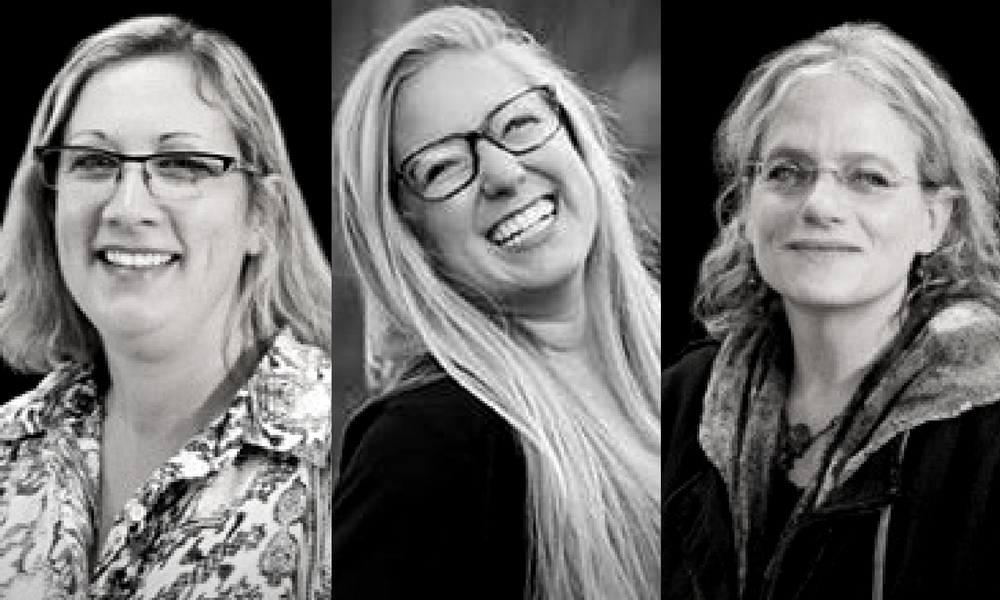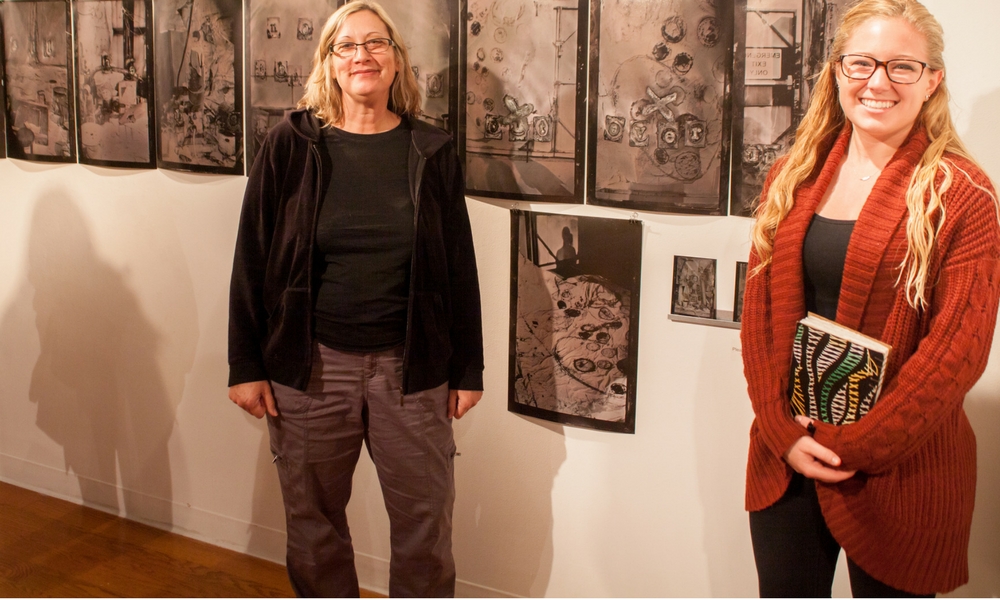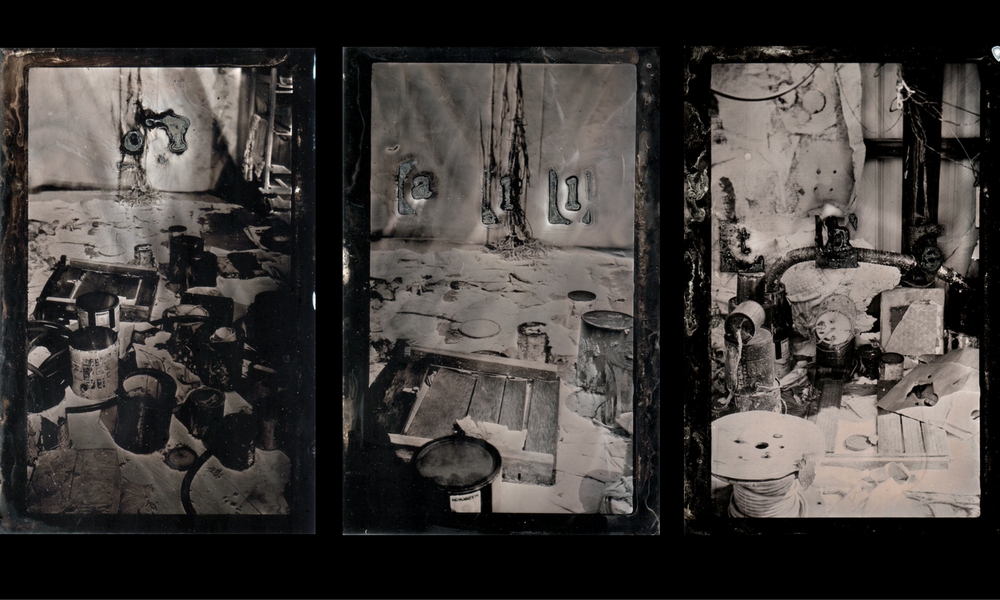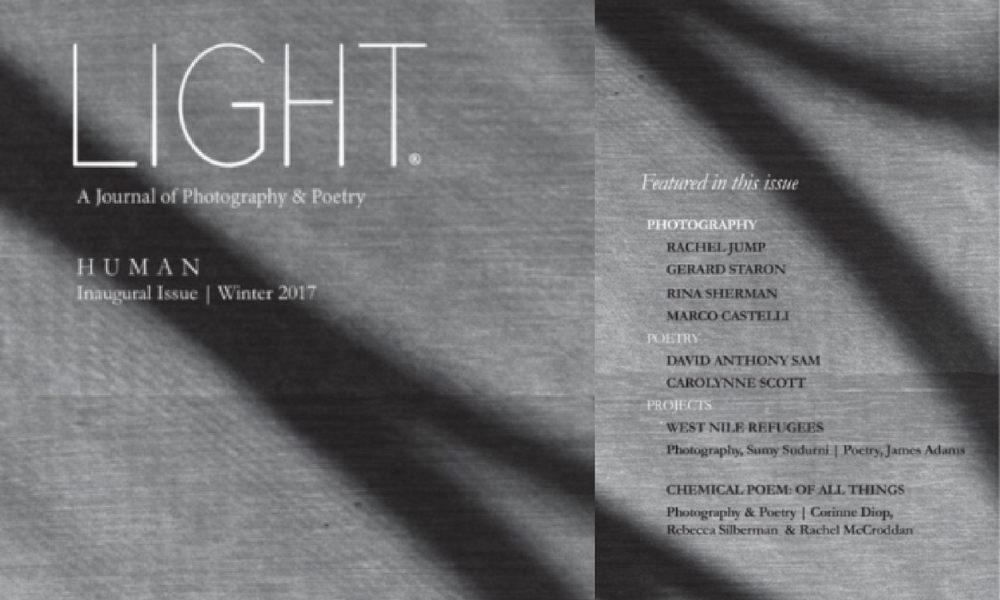Faculty and Student Collaborative Project
Leads to Journal Publication
School of Art Design and Art History
About the project
“chemical poem: of all the things” is a Metal Shed CoLab photography project originally undertaken for an exhibition of collaborations between students and professors, called “Emerging and Emerged” which was held Fall 2016 at artWorks Gallery at James Madison University. The Metal Shed CoLab is an evolving collaborative of faculty, graduates, and undergraduates who work with photo-based processes. This incarnation of the CoLab consists of Professor Corinne Diop, senior photography undergraduate, Rachel McCroddan, and Professor Rebecca Silberman. The “Metal Shed” is an affectionate designation for the photography labs (MHAC) located behind Memorial Hall.
The set represented is an outdoor studio space set up by Professor Corinne Diop. It was arranged and rearranged during two sessions where the chemical poem was written and recorded simultaneously, each image and word a response to the previously made plate. The actual images, tintypes on blackened metal, were created by Professor Rebecca Silberman and Rachel McCroddan, a senior Photography student, in collodion, a 19th Century photographic process. These plates are direct positives and are prepared with the chemistry just before use. The narrow time frame required for working with collodion or wet plate process, as it is otherwise known, inspired the words, branded in the wet chemicals as the images were exposed and echo the photographically recorded residue of the accumulated then absent items:
of all the things
no thing
left
out (Xed out)
over (Xed out)
undone
About the artists
Professor Corinne Diop works mainly in photography and processes using found objects. Diop collaborates and exhibits as Brown U Diop with Elizabeth Brown, a JMU math professor, and with Metal Shed CoLab, a varying group of James Madison University students and colleagues who use photography in their work. As an art professor in the School of Art, Design & Art History at JMU, Diop is interested in interdisciplinary strategies and creative pedagogy.
Rachel McCroddan is a senior at James Madison University, majoring in Graphic Design and Photography. Areas of interest include layout design, branding, illustration, and analog photography. She takes a very hands-on approach with her photography, and started experimenting with chemically branded stamps and fingerprints in the spring of 2016 in Intermediate Photography, Large Format, taught by Rebecca Silberman. She has been a part of several other exhibitions, including other artist and collaborative shows at artWorks Gallery, and the Larkin Arts Fibers Show. She plans to graduate in December 2016, and (hopefully) hike the entirety of the Appalachian Trail by the end of 2018.
Professor Rebecca Silberman is a Professor of Art, teaching all manner of traditional photography, ranging from 19th Century techniques through large format at James Madison University. Her special areas of interest include handmade sensitizers, low-tech adaptations, miniatures, optics and illusions. Her most recent work rethinks the language, form and content of tintype. She has been the recipient of many awards, including a Virginia Commission for the Arts Individual Fellowship, and has shown her work throughout the United States. Rebecca holds an MFA in Graphics (photography, printmaking and drawing) from Bowling Green State University in Ohio.
____________________________________________________________________________
 |
| Corinne Diop and Rachel McCroddan standing in front of "chemical poem: of all the things" at the Fall 2016 artWorks exhibit Emerging & Emerged |
How did you all get involved in the Emerging & Emerged exhibit collaboration at artWorks Gallery? Who approached whom and why?
Rebecca: Nava Levenson, director of artWorks this past semester, invited studio faculty to choose students and create collaborative projects. Since Rachel had done some really interesting work in ART 364, Large Format, where she purposefully added fingerprints and other marks to her negatives in development (and later in Portfolio credits, she was stamping letters onto the undeveloped film), it seemed there was some potential to do some interesting things with collodion. This process needs to be used quickly near a darkroom, so we asked Corinne if we could do something with her outdoor set which is on the patio at MHAC (Memorial Hall Art Complex). From there it all just fell into place, with Corinne setting up and arranging and Rachel and I making the plates and writing the words one image at a time as we exposed the plates to create this eleven image series.
Rachel: Yes, when Rebecca approached me and asked if I would like to collaborate with her and Corinne, I was obviously thrilled! How many students get to work hands-on with their professors? Not many. Rebecca was intrigued with the work I had been doing the previous semester with large format photography and we ended up combining our two styles – Rebecca’s knowledge of tintypes, and my experimental style – into one project.
For that artWorks show, the three of you created “a chemical poem.” Tell us about that work.
Rachel: We were photographing a set that Corinne had in the back of the photo studio. Rebecca and I met two times to take the photographs, and in between, Corinne would move pieces around in the set. We would then photograph different parts of it. It’s an incredible solution of mixing experimental photography with older photography methods (tintype) which were generally meant to be “perfect” photographs-- and by using rubber stamps and stamping into the chemicals, we were essentially disregarding everything that the art form has shown us in the past.
Rebecca: The process we used to write the letters involved using the photographic chemistry in an order in which it is not intended to be used. While we had no idea how this would work, we were pleasantly surprised to discover that our experiment altered the surface of the plate by creating a kind of crackling under the stamped letters. While the letters and words appear to be branded with heat, this is 100% a chemical experiment that just worked in our favor. Moreover, the imagery is also slightly swirling and altered around the stamping. This is also a fortuitous by-product of changing the order of chemicals already used in the process.
How did you start? What was your process?
Rebecca: I had been working with collodion on a portrait project over the summer. I wanted to use up my supplies, but because the light and perhaps the age of my materials had made the exposures too long for portraits (most of these plates are 20-30 second exposures), I thought it would be fun to teach Rachel how to work with collodion and do some experimenting to see if we could blend some components of her work with this other process.
Rachel: First Rebecca had to teach me how to do the wet collodion process. And let me tell you, it’s not easy! But she had complete confidence in me and after doing one plate as an example she tossed me into the deep end and let me take a crack at it. Apparently I was fairly decent at it, which was a huge relief. I didn’t want to be the inexperienced one to mess up the entire collaboration. We had to coat metal plates with the collodion chemical, constantly tilting the metal plate with one had to ensure an even coating of collodion was applied, then it is dropped into a silver nitrate bath, which essentially soaks into the collodion. While the plate was still wet with silver nitrate we dipped rubber stamps in fixer and stamped them directly into the plate, branding it. You take the photograph (while the plate is still damp – hence wet collodion) and then pour developer onto the plate from a beaker. You only get one shot at that and if you miss a section of the plate it ends up black. It’s immensely stressful. The plate then was soaked in a fixer bath, and then washed for 20 minutes.
 |
| Details from a "chemical poem: of all the things." Shown: of, all, the |
Working on a group project sometimes means competing points of view. Did ever that happen with the three of you? If so, how did you resolve it?
Rachel: That nearly never happened!
Rebecca: Since Rachel was learning the process, it was more of a workshop atmosphere. And because we were experimenting with how to use the collodion in an alternate way, it felt like we were discussing constantly..."What if we move closer to the subject?" "How ‘bout if we start to empty out the set?" "Where should the letters go on this plate?" We only made a few test plates for exposure and to figure out how to orient the letters right side up with the images (everything comes through the lens upside down and backwards). Every bit of it was shared and in using a time and labor intensive process, it is actually super helpful to have two people doing the process part in the darkroom, coordinating to make sure mistakes are not made or we didn't forget to add some detail or part of the process we needed to add. Toward the end of making the plates, we used our shadows as part of the subject matter as well, so some of the decisions were completely spontaneous. Corinne also changed the set for us once we had a sense of where the imagery was taking us. This also was organic and we were all in agreement about how things were unfolding.
What photographic techniques, technology, etc. did you use to complete the project?
Rachel: Wet Collodion Tintype. We scanned in the plates and then printed them out on metallic paper.
Rebecca: Collodion is a 19th Century process that is made from nitrocellulose and ether. It was originally a medical preparation--used like a sort of liquid bandaid on open wounds, particularly in the Civil War. The photo lab smells a bit like a hospital when we work with collodion (typically only photo grads have been permitted to work with this process besides me)! Once the collodion is poured on a blackened plate, it is then soaked in a tray of liquid silver nitrate which is what makes it light sensitive. By the way, you have to wear gloves while doing all of this because, while not dangerous, silver nitrate will stain your skin and nails brown for up to a year. As quickly as possible the plate is removed from the tray and is loaded into a re-purposed brownie camera that we use for this process, then rushed outside and exposed then rushed back in and developed before it can dry--in 10 minutes or less. Because these plates are direct positives and one of a kind, it becomes reproducible—a defining characteristic of photographs--through scanning and printing. These things coming together in this way, blending arcane processes with digital reproduction, has only been imaginable for a very short while. All the possibilities to reorder and reinvent a language around it is very exciting.
How often did you get together and how long did it take to complete the work?
Rebecca: We did the collodion work in two sessions as soon as the semester started, with the final session a marathon where we finished most of the plates all at once. You need warm temperatures and plenty of light, then the pressure to do everything perfectly is on.
Rachel took on the scanning after the series was done. We cleaned up the scans and made some tests on the metallic paper and then Rachel took another day to make the digital prints. Over Thanksgiving I varnished the series of original plates, because they will scratch with something as seemingly harmless as the bristles of a soft paintbrush if they are not protected. We didn't tally the hours, but lots of effort went into the series. I got on applying to things with it all almost before the collodion was dry and this has proved to be remarkably fruitful for us so far.
What do you want to say with those photographs, and how did you actually get your photographs to do that?
Rebecca: Above all, this series represents the collective skills of this incarnation of the Metal Shed CoLab and experimentation. But I think they also feel somehow timeless and full and empty in a kind of cycle—the series embraces contradiction on many levels. So much of what worked about this project was mysterious until we did it. It unfolded into an outcome which was so much more than the sum of its parts. Maybe this can be attributed to the magic that happens when people work together on something bringing different skills and ideas to a shared goal of creating something meaningful and interesting.
Rachel: Personally, I wanted to show people that photography isn’t an art form that is set in stone and there is so much that can be changed when it comes to old processes like tintype and even large format photography. It’s up to the photographer to be willing to step away from the perfection of the “straight” photograph and dive into the unknown and really get to know the materials and what they can and can’t do. I think it definitely shows that not all photography has to be clicking a button and getting a picture. There’s really so much more to it and I definitely think this project demonstrates that idea.
 |
| Light journal cover, featuring "chemical poem: of all the things" |
And congratulations! “ chemical poem” is now published in the inaugural issue of Light, a quarterly journal of fine art photography and poetry. How cool for a student to be included in this publication as a published artist! How did this opportunity take place?
Rachel: Rebecca is the one that found the journal and tossed it up as an idea to submit to it. Corinne and I both agreed, not knowing for sure if we’d get chosen. But it’s incredible that we did. Then again, we have done something that no one in the history of photography has done before.
Rebecca: Several more applications are pending as well. I started looking for ways to get this out there as a collaboration and photography project right away. The Light Journal submission was due the weekend we finished with the collodion series. I made some smaller scans, wrote up the project description and sent it out. This project got into the very first thing we submitted to—an international call for photography and poetry.
How did this experience change you?-- as people, as faculty, as a student, as artists, etc.?
Rebecca: I love this as a model for teaching and learning and plan to keep working in this way every semester with students who clearly are working hard and are earnest in their ideas and risk taking. The eye-opener for me is how everyone is learning and sharing together which is different than the usual instructional approach to working with students. This also demonstrated the end result can be successful in a way that an individual could never arrive at alone.
Rachel: Working with professors has definitely opened my mind to the fact that in any art form there are truly unlimited possibilities with what the medium can do. It’s also given me a little bit of insight to how professionals work, which is awesome. I think it’s great that professors still get just as excited about bodies of work as their students.
